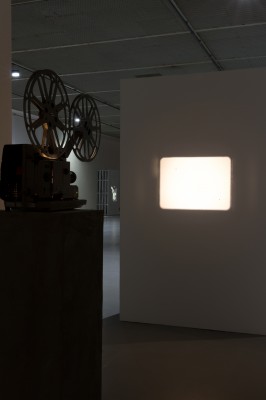 |
| David Maljković, view of New Reproductions, 2013. Image: Contemporary Art Centre. |
Boredom and unnecessary repetition are looming threats for any contemporary artist or astute curator. Croatian artist David Maljković’s current solo exhibition, in a location that purports to be the largest exhibition space in the Baltic region (nearly 26,000 square feet), attracts attention due to the artist’s decision to reassess his previous projects with an emphasis on altering perception. The same exhibition space hosts an extensive Fluxus archive highlighting the creative efforts of Lithuanian-born American artist George Maciunas. The newly revisited work by Maljković appears linked to and influenced by Lithuania’s international avant-garde 1960s Fluxus movement, whose name originates from the Latin variant meaning “flow, flux, flowing, fluid.” The six new readings, which are displayed as slide projections, animations, complementary sculptures, and seemingly arbitrary objects, are not static; their colorful reflections and ripples are exhibited with grace, beckoning curiosity.
New Reproductions, 2013, displays overlapping images from previous works in a series of five collaged posters. Afterform, 2013, provides cartoon animations appropriated from a 1960s Croatian architectural magazine alongside Maljković’s earlier works that are projected onto a white screen. Both works, in addition to After the Fair, 2009 (tarpaulin and reflector incorporated in a tinkering, sculptural fashion), question ways in which artists relate to bricolage as well as relevant methods utilized in conventional, retrospective exhibitions. To a degree, the artist adopts the role of curator in his decision to consciously redesign previous works as new versions; content itself is recycled and realigned, yet harbors similar components. In this instance, the standardized positions of artist (David Maljković) and curator (Jurga Daubaraitė) bleed into each other, possibly in tribute to Fluxus. Depending on how one interacts with the works, any chosen quizzical narrative takes precedence over another—sometimes fragmented and interrupted and other times linear and consequential. An observer’s comfortable tendency to see in only one way limits the viewer and the viewed; in a fashion akin to how one reconsiders memories, over time the reality of any incident may become warped. “New Reproductions” is an invitation to avoid pretense and self-confidence. The world contradicts itself—especially, when one trusts perception alone.
To see the review in context, click here.








